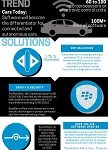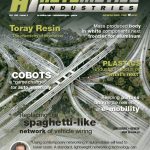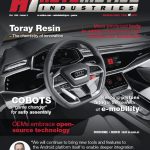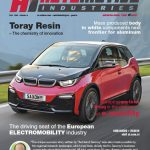Vehicle makers are starting to focus as much on the electrical power consumption of a growing number of electronic components in a vehicle as on the consumption of the power plant.
Electrical power-hungry equipment puts more load on engines and, in the case of electric vehicles, the battery packs – reducing range in both cases. Much of that equipment is being used to connect vehicles to their immediate environment and beyond.
Automotive Industries (AI) asked Patrick Little, Senior Vice President and General Manager Automotive at Qualcomm, what the company’s vision is for the next generation of vehicles.
Little: Connecting the car is probably the biggest transformation going on in the automotive world. It cuts across everything, from aesthetics to the powertrain. We started connecting cars through the Internet in 2002-2003 with the GM OnStar program, which used eCall. It is interesting that it started with safety in mind. Then the industry introduced remote diagnostics to further improve safety. About three years ago everything in the car started getting very media rich.
Moving the whole multimedia experience into the car has driven connectivity over the past few years. In 2017 the big focus wass going back to personal productivity and safety. The productivity part comes in where a car is able to talk to the infrastructure such as traffic lights, other cars around it, and even pedestrians stepping off the curb in order to analyze traffic patterns to choose the quickest route.
In-car technology, such as our 9150 chip V2X modem, allows vehicles and drivers to connect to everything in their environment. In the direct mode the vehicle connects with its surroundings through point-to-point local connections. Out in the mountains with no cellular connection you can still use cellular V2toX to connect to other cars or infrastructure – in fact, anything or anyone with a handset. When you connect through both point to point links and the Internet you download richer maps, more traffic information or other broadcasting information that can help your car be more aware of not just the next mile, but the next 20, 30 or 100 miles.
As we move to autonomy, I think one of the most important sensors will be V2X (you can view cellular as a sensor just like radar and lidar). What none of the line of sight technologies can do is see around the corner and say there is a car coming very fast and it is not going to stop. V2X is therefore one sensor that we cannot live without.
AI: How does wireless connectivity transform the in-car experience?
Little: In terms of the in-car experience what we are doing is simply two things. One is driving a path to full connectivity, and the other is using software to emulate the capability of your phone. Infotainment solutions are starting to become incredibly powerful. The screens are getting bigger and even in mid to low-range vehicles there are now multiple screens. Our range of infotainment products is designed to keep up with the multimedia and graphics trends. We are the first to embed a modem into an infotainment system, which allows vehicles to download from the web while at the same time providing content-rich entertainment or information to the driver.
In order to reduce the amount of power consumed by the system we have moved away from being very CPU or GPU-centric. Our background is making the mobile handset work on a minimum amount of power. I believe this will become critically important as we move to electric vehicles because anything that uses power shortens the range of the car.
AI: What has changed in the supply chain relationships?
Little: It used to be in the past that you would make a product, you sell it to the Tier 1s and the Tier 1s put it in a solution and sell it to the automakers. That model is changing. I personally and our company have direct collaborative relationships with every major automaker. No one company can provide all the solutions on its own any more. There is a bigger ecosystem of players that have to co-ordinate with each other very closely.
The cellular network operators are becoming part of it. Road sign and infrastructure companies like SWARCO have to get involved because their signs now have to talk wirelessly to vehicles on the road. Standardization for cellular V2X or for DSRC, and standardization for autonomous vehicles is becoming increasingly important. Regulators really have to play a central role in helping to set some of these mandates.
AI: What are the biggest challenges in connecting vehicles to everything?
Little: I don’t think it is the technology, because we already have the technology. The bigger challenge is to get everyone to agree on the eco system. We need to agree on which spectrums we are going to use. DSRC for V2X and cellular V2X are going to have to work co-operatively together in the 5.9 Gigahertz band. Standardization is going to become very important. And everyone in the eco system is going to have to get involved and helping to set these standards.
AI: How is your technology contributing to the rollout of autonomous vehicles?
Little: Autonomous vehicles need to sense, think and act. The sensing is going to happen very quickly. We already have LiDAR, radar and camera sensors. They have to get more cost-efficient, but that is going to happen. Cellular V2X is a big breakthrough in that suite of sensors. The protocols for activating brakes, changing lanes or even deploying the airbags are very well known.
We also know how to design a computing core which is able to analyze all the inputs and to take decisions with low latency. In addition we have artificial intelligence and machine learning, because the autonomous drivers’ decisions have to continuingly improve just like your decision-making has been hopefully been constantly improving since obtaining your drivers’ license.
Cellular technology also plays a very key role there. Once you’ve sensed it, you’ve made the decision, and you successfully actuate a maneuver you want other cars to share that information. So, you socialize machine learning in the cloud and cascade it. Crowd sourcing for autonomy and traffic management has become very important.
AI: What new mobility EV technologies are you developing?
Little: A lot of what we are trying to do is save lives, and also to improve the quality of life. For electric vehicles to become the dominant form propulsion we have to get over range anxiety. Energy efficiency is playing an important role, and this is where Qualcomm has a unique advantage. Because of our background this is second nature to us. We owe it to our culture and to our planet to move there as quickly as we can, but is going to require improvements in battery technology; and everything in the car is going to have to use less power. And, when it comes to recharging, we have a wireless solution called Halo.
AI: What is next for Qualcomm?
Little: This is an incredibly exciting time. We will continue to drive the connected car experience all the way from eCall to safety, through productivity, through convenience and eventually through safety and into autonomy. We will continue to work on connectivity and we will continue work on compute all the way to full autonomous solutions together with our automaker partners.














































 Cybersecurity for the Enterprise of Things
Cybersecurity for the Enterprise of Things Don't let the spaghetti mess under the hood slow self-driving innovation
Don't let the spaghetti mess under the hood slow self-driving innovation Meeting the need for an increasingly diverse range of propulsion systems
Meeting the need for an increasingly diverse range of propulsion systems In-car Android system now available
In-car Android system now available TomTom shifts gear from consumer to B2B focus
TomTom shifts gear from consumer to B2B focus Saxony reinventing itself as home of electro-mobility
Saxony reinventing itself as home of electro-mobility


